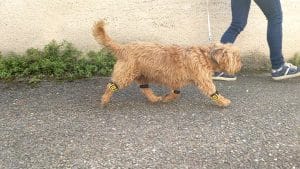Just like any athlete, both animals and humans can suffer injuries related to their activity.
These injuries can range from mild to more serious. That’s why proper preparation and preventive measures are essential for any canine sporting practice.
The health and well-being of the animals must always remain a priority to ensure enjoyable and safe sporting moments shared together.
What are the most important sporting disciplines for dogs?
Dogs are increasingly participating in a wide variety of sporting activities, each with its own specific rules and characteristics. Canicross is one such canine sport that is gaining popularity and media attention. This sport involves running with your dog, much like a traditional human race, where the goal is to cover a certain distance in the shortest possible time — but this time, with your dog.
⚠️ Please note that certified and appropriate equipment is required for competition.
Other related activities include walking (caniwalk), hiking (canihike), or trail running (canitrail) with your dog. Similarly, you can also practice biking (cani-MTB or canibike).
Agility is another well-known canine sport where a dog must complete an obstacle course off-leash, navigating the challenges as quickly and accurately as possible. Speed is also a key factor here.
Obedience is a discipline based on communication between the handler and the dog. The dog must respond correctly to given commands such as sitting or lying down. Strong teamwork and connection between the dog and handler are essential in this sport.
Long-distance sled dog racing is another major canine sport. As the name suggests, it involves covering great distances with a team of dogs pulling a sled. This sport, also known as mushing, includes long-distance racing as one of its categories. Given the often extreme conditions of competition, thorough preparation is crucial.




To learn more about preparing a dog for long-distance racing:
What are the most common injuries in sporting dogs?
As you can understand, these various canine sports require proper preparation, just like for humans and horses.
However, injuries can sometimes occur, both during training and competitions. Indeed, just like in humans, illnesses and conditions related to sports practice can affect dogs. Since certain muscles are heavily used during exertion, musculoskeletal injuries are common in sporting dogs.
For example, traumatic injuries called exogenous injuries are those related to an external factor. This could be a fall, a collision between dogs, or an impact with an object.
Endogenous traumatic injuries, on the other hand, are linked to internal damage caused by the sporting movement. Examples include cramps, muscle soreness, tears, strains, sprains, or even muscle ruptures.
Several disorders can therefore cause pain and lameness in sporting dogs.
In general, any fall or impact can lead to wounds of varying depth depending on the severity. Veterinary care may sometimes be necessary, including surgery. At the bone level, fractures and dislocations can also occur.
Early detection of osteoarthritis in the sporting dog in this article:
Some conditions are also related to climatic factors. For example, during intense physical effort in high heat, a dog can suffer from heat stroke during or after exercise. Conversely, in very cold conditions such as in the mountains or snow, cold-related injuries and disorders may occur (such as on the paw pads, etc.).
To conclude this non-exhaustive list, just like humans, sporting dogs can also suffer from certain heart conditions.
What are the prevention methods and recommendations to apply in order to avoid these injuries?
To prevent any injury, proper preparation of both the owner and the dog is essential. Several factors contribute to muscle injuries in dogs, including the animal’s weight, muscle mass, and diet. Training that is adapted to the specific sport helps prepare the muscles for the effort required.

That’s why it is recommended to follow a training program and not hesitate to seek advice from specialists (veterinarians, osteopaths, masseurs, etc.) to benefit from their expertise.
Respecting adequate rest periods and allowing for recovery after exercise are also important recommendations.
Since nutrition is equally important, consulting a veterinary nutritionist is advised. Indeed, obesity, overweight, age, and lack of physical preparation are all factors that can contribute to injuries.
Moreover, climatic conditions and the terrain may be very different from the dog’s usual training environment. Preparation in this regard should not be overlooked. Therefore, equipment adapted both to the animal and to the climatic conditions is recommended.
The intensity and duration of work are important factors to consider in preparing a sporting dog. Finally, the entire training program should also take into account the individual dog: its age, body type, breed-specific characteristics, and so on. Don’t hesitate to seek help from a veterinarian specializing in canine sports medicine.
Want to know more about Tendiboots™ Canine?
Veterinary Associations Specializing in Sports Medicine
There are several associations of veterinarians specializing in canine sports medicine:
In Italy, for example, there is AMESVI: https://www.amesvi.it
For sled dog sports, the International Sled Dog Veterinary Medical Association (ISDVMA) is active: https://isdvma.org
In the UK, the British Veterinary Rehabilitation and Sports Medicine Association (BVRSM) is also noteworthy: https://www.bvrsma.org.uk
Sources
- Fédération française des sports et loisirs canins : https://ffslc.fr
- Virginie FOURIEZ-LABLÉE. Les affections musculaires chez le chien de sport. Thèse de médecine vétérinaire. Faculté de médecine de Créteil, 2004, 83 p.










